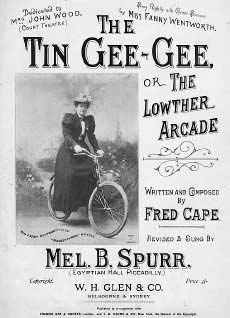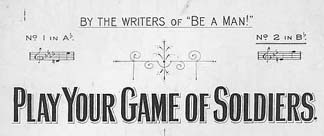 Various wargaming newsgroups on the Web often raise the question of which music we listen to while wargaming. What sets the mood for a good tabletop battle? Of course, the period we're fighting makes a difference. Ancient wargamers often mention the soundtrack music from Gladiator. I prefer the soundtrack from Conan the Barbarian, or the "Mars" sequence from Gustav Holst's Planets. There's lots of music available for American Civil War games and more modern wars. There's lots of music to provide an auditory background for our games, but we wonder if there's much music devoted to the hobby as opposed to its real world counterpart. Tchaikovsky presents one obvious balletic piece, but what else may be out there?
Various wargaming newsgroups on the Web often raise the question of which music we listen to while wargaming. What sets the mood for a good tabletop battle? Of course, the period we're fighting makes a difference. Ancient wargamers often mention the soundtrack music from Gladiator. I prefer the soundtrack from Conan the Barbarian, or the "Mars" sequence from Gustav Holst's Planets. There's lots of music available for American Civil War games and more modern wars. There's lots of music to provide an auditory background for our games, but we wonder if there's much music devoted to the hobby as opposed to its real world counterpart. Tchaikovsky presents one obvious balletic piece, but what else may be out there?
Surprisingly, a search of a worldwide library catalog found several songs devoted to toy soldiers. Remembering that H.G. Wells' Little Wars appeared in 1913, and that the preceding decades saw the publication of several minor wargaming items, perhaps it shouldn't have been that unexpected. The first pieces I ran across were sheet music songs, perhaps music hall items. The Tin Gee-Gee, or The Lowther Arcade relates the story of a "colonel in a little cock'd hat"...who rides "on a tin gee-gee." The colonel resides in a toyshop and his greatest wish is to be marked up in price to impress a "little dolly-girl" who he's in love with. The doll is a bit of a snob and turns her nose up at him since his price is too low. A quick switch of price tags by the song's narrator fixes the little fellow's problem.
Love is also the theme of Hans Christian Andersen's, "The Steadfast Tin Soldier." This story is about a one-legged tin soldier and his quest to find his love, a paper-doll ballerina. A goblin's curse, or simple bad luck, sends the soldier on a journey through the streets and canals of the city. He bears all his troubles stoically, too soldierly to shed a tear or bend a knee, and ends up back at home in the belly of a fish. In a finish typical of Andersen, the tin soldier and his paper doll amour meet their respective fates in the playroom's fireplace as a lump of melted tin in a heart's shape and a bit of blackened bangle. Georges Bizet's 1871 Jeux d'Enfants was the musical basis for a ballet version of the story. It was choreographed in 1955 by George Balanchine, Francisco Moncion, and Barbara Milberg, and reworked in 1975.
 More appropriate to the subject, perhaps, are the more martial stories in the following compositions, including the Nutcracker Suite (1892). This is a popular Christmas piece that regularly appears on stage and screen around the holidays. Peter Ilyich Tchaikovshy based this well-known ballet on ETA Hoffmann's 1816 story "The Nutcracker and the Mouse King", as revised by Alexander Dumas. In a dream sequence, an army of mice fights the nutcracker prince and his group of toy soldiers as the Mouse King tries to kidnap young Clara, the nutcracker's new owner. The soldiers prove no match for the mice and it is only when Clara kills the Mouse King by hitting him in the head with her shoe, that the mouse army retreats, leaving the ballet free to proceed with its further adventures.*
More appropriate to the subject, perhaps, are the more martial stories in the following compositions, including the Nutcracker Suite (1892). This is a popular Christmas piece that regularly appears on stage and screen around the holidays. Peter Ilyich Tchaikovshy based this well-known ballet on ETA Hoffmann's 1816 story "The Nutcracker and the Mouse King", as revised by Alexander Dumas. In a dream sequence, an army of mice fights the nutcracker prince and his group of toy soldiers as the Mouse King tries to kidnap young Clara, the nutcracker's new owner. The soldiers prove no match for the mice and it is only when Clara kills the Mouse King by hitting him in the head with her shoe, that the mouse army retreats, leaving the ballet free to proceed with its further adventures.*
Leon Jessel's 1905 "Parade of the Wooden Soldiers" is a delightful little march. Ballard MacDonald put it to words in 1922. The lyrics take us back to a toyshop where, once the shop closes and the clock tolls midnight, a time of night with a similar effect in Andersen's tale, the toy soldiers do their parade, showing off for the dolls.
- Hark to the drum, oh, here they come
Cries ev'ryone
Hear them all cheering
Now they are nearing
There's the captain stiff as starch
Bayonets flashing
Music is crashing
As the wooden soldiers march
 The tune was part of a musical revue called The Bat, which opened on Broadway in 1922 with Ballard's lyrics added to the dance routine. The music was the theme of the BBC Radio series "Toytown" for many years. (Jessel)
The tune was part of a musical revue called The Bat, which opened on Broadway in 1922 with Ballard's lyrics added to the dance routine. The music was the theme of the BBC Radio series "Toytown" for many years. (Jessel)
Finally, our musical journey takes on a more serious note. Our venue finally shifts away from toy soldiers in fantastic situations to a boy playing with his toys in "Play Your Game of Soldiers." In this 1916 piece, we have a young lad in tears as his father goes off to war, not from fear, but from jealousy. The tune encourages him to play his games "with a box of soldiers, Soldiers made of paint and lead. But play your game of soldiers, Brush your tears away!" For "British baby boys will all be British men some day" and be able to carry their own rifles. (Pether)
With the exception of the final piece, all of this music is on the light side. Fine for parades of toy soldiers, but not really mood music for the fierce battles on our tabletops. For that we go back to Holst, Wagner, and the many film music composers whose music is often more evocative than the movies they write for.
Sources:
Andersen, Hans Christian. Trans. Mrs. E. V. Lucas & Mrs. H. B. Paull. Andersen's Fairy Tales. New York: Grosset& Dunlap, 1945.
Cape, Fred. The Tin Gee-Gee, or The Lowther Arcade. Melbourne: W. H. Glen, 1910?
Jessel, Leon. Parade of the Wooden Soldiers. 1905. Lyrics by Ballard MacDonald, 1922. in Simon, William L., ed., Reader's Digest Merry Christmas Songbook. N.p.: n.p., 1981.
Pether, Henry E. Play Your Game of Soldiers. London: Francis, Day & Hunter, 1916.
Tchaikovsky, Leon Ilyich. Nutcracker Suite. 1892.
* Nutcracker graphic from: http://www.bethanyroberts.com/NutcrackerStory.htm
Back to The Herald 55 Table of Contents
Back to The Herald List of Issues
Back to MagWeb Master Magazine List
© Copyright 2003 by HMGS-GL.
This article appears in MagWeb.com (Magazine Web) on the Internet World Wide Web. Other articles from military history and related magazines are available at http://www.magweb.com